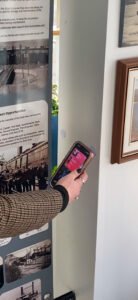
Provenance isn’t just a record of ownership—it’s the historical and cultural story behind an artwork. Knowing who created a piece, where it has been, and what it represents deepens understanding and appreciation. For museums and galleries, this context is invaluable, helping to preserve authenticity and showcase the significance of their collections. But while provenance has traditionally been locked in archives or printed in catalogs, online collections have made it possible to bring these stories to everyone’s fingertips.
In the digital space, provenance takes on a new level of importance. It allows visitors to explore the full narrative of an artwork in ways that aren’t possible in a physical setting alone. Through an online collection, a visitor can learn about the artist’s influences, the cultural movements that shaped the piece, the previous owners who valued it, and the historical events it has witnessed. High-resolution images, interactive timelines, audio descriptions, and curated multimedia content enrich these stories, making provenance more engaging and accessible to a wide audience.
Accessibility and Online Provenance: Opening Doors for All Visitors
For individuals with disabilities, online collections provide access that might not otherwise exist. Physical spaces often come with barriers—text-heavy wall labels, displays placed at difficult angles, or a lack of alternative formats for engaging with information. Online collections break down these barriers by presenting provenance in multiple, user-friendly formats.
Visitors with visual impairments can listen to audio descriptions of the artwork’s history. Those with cognitive disabilities can engage with simplified timelines and clear, concise explanations. For individuals who struggle with reading small text or have certain motor impairments, interactive design, screen-reader compatibility, and adaptable interfaces ensure that they can access the same rich information as any other visitor.
Online provenance also allows for customization. A visitor can adjust text size, switch to a high-contrast mode, or translate the content into another language—all at their own pace and on their own device. This level of accessibility empowers people to engage with art and history independently, creating an inclusive experience where everyone can connect with cultural narratives without needing special accommodations or assistance.
Why Online Provenance Matters
Ultimately, online collections with accessible provenance information serve as a critical bridge between cultural heritage and modern inclusion. They provide museums and galleries with a way to share their stories more broadly, reaching diverse audiences around the world. For people with disabilities, these collections are a gateway to experiencing art and history in ways that were once out of reach. They ensure that no visitor is left out of the journey through an institution’s treasures, and they transform provenance from a background detail into a central, engaging narrative for all.
Bringing Provenance to Life Through NFC Technology
At CANUS Museum Consultants, we use innovative NFC technology to transform how museums and galleries present their collections. By pairing exhibits and artworks with tappable NFC tags, we provide visitors instant access to a dedicated webpage filled with rich provenance information. This includes the artist’s story, historical context, past owners, and related works. It’s more than data—it’s a narrative that connects people to the essence of art and history.
A System Designed for Everyone
Our system ensures every visitor, regardless of ability, can explore exhibits independently and engage deeply with the content. Accessible features include audio guides, high-resolution visuals, adjustable text sizes, high-contrast modes, and multilingual options. By presenting provenance through multiple formats, museums and galleries create a more inclusive, engaging experience for all visitors. This approach not only aligns with accessibility standards but also empowers visitors to connect with exhibits on their terms.
 Enhancing Visitor Engagement and Institutional Credibility
Enhancing Visitor Engagement and Institutional Credibility
Implementing NFC technology enhances the overall visitor experience by offering:
Richer Interactions: Tappable tags deliver stories and multimedia content that deepen understanding.
Greater Accessibility: Every visitor—regardless of visual, auditory, or cognitive ability—can enjoy the collection.
Increased Transparency: Detailed provenance builds trust and confidence, especially for potential buyers and donors.
Stronger Community Ties: An inclusive, immersive approach fosters meaningful connections, encouraging repeat visits and community engagement.
Elevating Museums and Galleries
With NFC-driven access to comprehensive provenance, museums and galleries don’t just display artifacts—they tell compelling stories.
Visitors leave with a deeper appreciation of the pieces they encounter, and the institution strengthens its reputation for innovation and inclusivity. As provenance becomes more than a historical record, it transforms into a vibrant, accessible narrative that speaks to everyone.
Take the Next Step
We believe that making art and culture accessible benefits everyone. CANUS Museum Consultants can help you create an inclusive space where all visitors—regardless of ability—can independently explore and connect with exhibits.
Contact us today to learn how our system can help your museum or gallery engage visitors, tell richer stories, and foster a more inclusive cultural experience.
- Vanessa Chatten, Vanessa@museum-Consultant.com
Visited 32 times, 1 visit(s) today